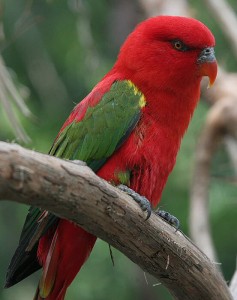Black Cap Lory care guide
Distribution and Habitat
Black-capped Lories is found in New Guinea and adjacent smaller islands. Their natural habitat is in lowland forests and surrounding secondary vegetation.

Longevity
The life span of the Black Cap Lory is years 25 to 30 years.
Description and Sexing
Black Cap Lories are a medium sized stocky bird with a short, slightly rounded tail, average height about 31cm. They have green wings, red head and upper body, a black cap and blue legs and belly.
Cap Lory as an Aviary Bird
In larger aviaries, Black Cap Lory mix well with other Black Cap Lories, Moluccan Lories and similar sized Lories. With any birds always be careful when introducing a new bird into the flock as sometimes just like people an individual can have a bad attitude. It is recommend when introducing a new bird into the flock, to have what I call a soft release cage. The new bird is place in this cage inside the aviary and all birds are able to adjust, interact and get use to each other. After two weeks then introduce the bird into the aviary. This should stop the original bird from mobbing the intruder.
Breeding
Black Cap Lories reach matures at 8 month or later.
In order to breed you must provide a nest box and fill with substrate, which are available from Birdsville.
Clutches consist of an average of two eggs, which will incubate for a period of 24 days.
Sometimes, Black Cap Lories are prone to breaking or eating their eggs. There
may be a number of reasons for this, but most common is a lack of calcium, to resolve this use a calcium supplement in the water, which is avaibable at Birdsville.
The young will fledge in 10 weeks, and are fully mature by 11 months of age. Some pairs
will breed three times in a year. They should remain with their parents for about two weeks before they are separated and hand reared.
Diet
Black Cap Lories have specialized brush-tipped tongues for feeding on nectar and soft fruits. They can feed from the flowers of about 5,000 species of plants and use their specialised tongues to take the nectar. The tip of their tongues have tufts of papillae (extremely fine hairs), which collect nectar and pollen.
Black Cap Lorries unlike most parrots don’t eat seed, in the wild lorikeets feed on nectar and pollen from plants and flowers. Pet lorikeets require a nectar replacement diet, which are available at Birdsville. These mixes come in powder form and there are two main types of nectar replacement,
Dry mix (Lorri-dry) – with dry, plenty of fresh drinking water needs to be made available for the bird.
Wet mix (Lorri-wet) – with wet, their requirements for drinking will be reduced, as the feed contains a large amount of water, however fresh drinking water should still be made available.
Young birds should be feed on both wet and dry mix in separate containers and can later be weaned on to dry mix only.
Black Cap Lories also need their diet supplemented with fresh fruit and vegetables on a daily basis. Spinach or silverbeet leaves are important to provide calcium for the bird, due to the shape of their beak and tongue they will rarely use a cuttlefish. Your bird with also require vitamin mixed into their water every two to three days. This is to provide essential nutrients commonly deficient in their diet.
Do not feed your bird (or any other bird) avocado, onion, chocolate, caffeine or alcohol.
Introducing your new bird to existing birds
Once you take your bird home you should keep it in a separate cage and allow the bird to adjust accordingly. Always allow at least 2 weeks before introducing the bird to an existing bird.
Hygiene
The cage requires regulars cleaning and old food shouldn’t ‘be allowed to accumulate in the cage, on perches or in feeders. Water should be changed daily basics.
Worming
Your bird will need to be wormed in a few weeks to two month after being taken home (check with the staff from Birdsville, when purchasing). Worming will need to be done every 6 month.
Lice & Mites
These are the two most common parasites of cage birds and their environment, but are easily controlled with a Mite and Lice spray, available at Birdsville. When using spray, spray bird, entire cage, perches, nesting box and toys, remember to remove all water and
feed and avoid spraying in birds’ eyes.
Training
This is an important factor of having a well behaved hand raised bird. The bird need to be
handle in a quiet, relxed situation, but don’t over stress your bird in the first few weeks of taking it home. The more time you spend with your bird, the better your bird will become.


